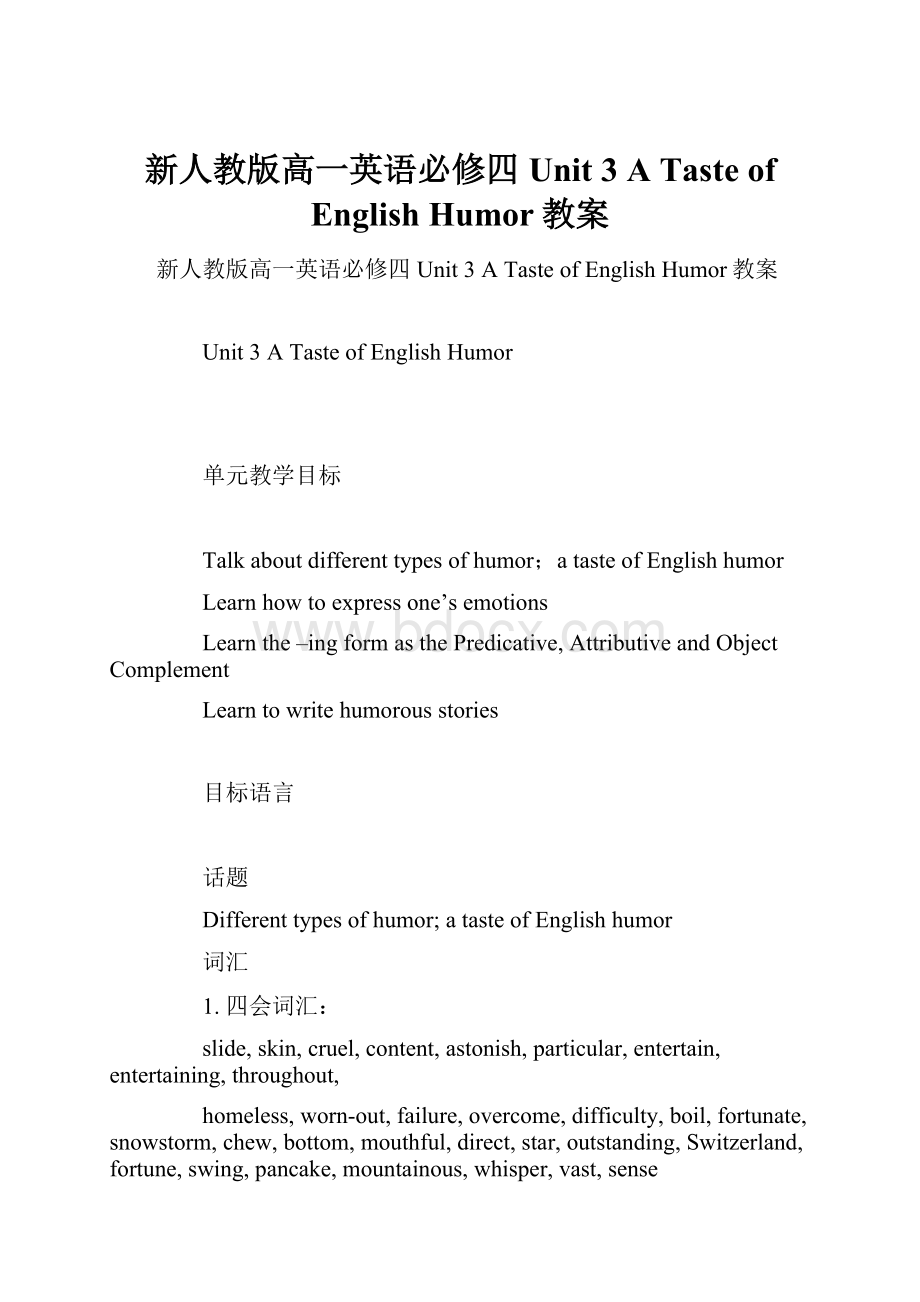新人教版高一英语必修四 Unit 3 A Taste of English Humor教案.docx
《新人教版高一英语必修四 Unit 3 A Taste of English Humor教案.docx》由会员分享,可在线阅读,更多相关《新人教版高一英语必修四 Unit 3 A Taste of English Humor教案.docx(17页珍藏版)》请在冰豆网上搜索。

新人教版高一英语必修四Unit3ATasteofEnglishHumor教案
新人教版高一英语必修四Unit3ATasteofEnglishHumor教案
Unit3ATasteofEnglishHumor
单元教学目标
Talkaboutdifferenttypesofhumor;atasteofEnglishhumor
Learnhowtoexpressone’semotions
Learnthe–ingformasthePredicative,AttributiveandObjectComplement
Learntowritehumorousstories
目标语言
话题
Differenttypesofhumor;atasteofEnglishhumor
词汇
1.四会词汇:
slide,skin,cruel,content,astonish,particular,entertain,entertaining,throughout,
homeless,worn-out,failure,overcome,difficulty,boil,fortunate,snowstorm,chew,bottom,mouthful,direct,star,outstanding,Switzerland,fortune,swing,pancake,mountainous,whisper,vast,sense
2.词组:
becontentwith,badlyoff,pickout,cutoff,starin,knockinto
功能
情感(Emotion)
Ienjoythisverymuchbecause…Itsurprisesmethat…
Ilaughatthatkindofthingbecause…Ifelthappybecause…
Thisisfunbecause…I’mpleasedwewerebothamusedat…
Howwonderful/surprising!
It’samusingthat…
语法
动词的-ing形式作表语,定语和宾语补足语的用法
Theirjobis“panningforgold”.
ThatwastheproblemfacingCharlieChaplin.
Doyoufinditfunnytoseesomeoneslidingonabananaskin?
课时分配
1stPeriodReading
2ndPeriodSpeaking
3rdPeriodGrammar
4thPeriodListening
5thPeriodWriting
6thPeriodSummary
分课时教案
PeriodOne
Teachingaims:
EnablestudentstotalkaboutsometypesofEnglishhumorandChinesehumor.
Keypoints:
HelpstudentslearnhowtounderstandandenjoyEnglishhumors.
Difficultpoints:
HelpstudentsknowthedifferencesbetweenEnglishandChineseinhumor.
Teachingaids:
pictures
Teachingprocedure:
Step1:
Lead-in
Showsomepicturestostudents,letthemtalkaboutthepicturesandthenaskthemwhattheythinkofthepictures,whethertheyarefunnyornot.
Questions:
1)Doyouknowwhothesecomediansare?
Whatmakesthemfunny?
2)Doyouknowothercomedianswhoarefunnyinthesameway?
3)Haveyouseenanyofthesecomediansorprogrammers?
Whatdoyouthinkofthem?
Step2:
Warmingup
Task1.Brain-storming
Askstudentstonamesometypesofhumorstheyknow.Writethosetheyarenotfamiliarwithontheblackboard,thenshowsomepicturesandsummarize.
Typesofhumor
ExampleofEnglishhumor
Chinesehumor
Nonverbal
CharlieChaplin
Pantomimes(哑剧)刘全和,刘全利
Mimeandfarce
Mr.Bean
Funnyplays陈佩斯,赵本山
Verbaljokes
Playonwords,usually
Crosstalk马季,姜昆
Funnystories
Twolines
Jokes
Funnypoems
EdwardLear
Doggerel(打油诗)
Task2.Talking
Askstudentstotalkaboutsomefunnystories,anyEnglishorChinesehumorstheyknow.
Task3.ReadingonP22
Thepurposeofthereadingistointroducethekindofverbaljokes.Theyusea“playonwords”tobefunny.Letstudentsreadthethreejokesandthenmatchthejokewiththeexplanation.Thenchecktheanswer.Afterthat,teachercanshowsomeotherjokesonthescreen.
Joke1:
Patient:
Doctor,I’velostmymemory.
Doctor:
Whendidthishappen?
Patient:
Whendidwhathappen?
Joke2:
Garcia:
Thankyoudoctor.Myfeverisgone.
Doctor:
Don’tthankme.ThankGod.
Garcia:
ThenIwillpaythefeestoGod.
Step3Homework
Askeachstudenttogiveajokeandpresentitinclassnextperiod.
PeriodTwoReading
Teachingaims:
Enablestudentstolearnwhathumormeansandwhatisnonverbalhumor.
Keypoints:
Helpstudentsdividethetextintoseveralpartsaccordingtothemeaning.
Difficultpoints:
Dividetheparagraphsandgivethemainideas.
Teachingaids:
Arecorderandaprojector
Teachingprocedure:
Step1.Revision
Checkhomework:
askstudentstopresenttheirjokesinclass.
Step2.Pre-reading
Questions:
(1)Whatdoyouliketolaughat?
(2)Whatdoeshumormean?
Ishumoralwayskind?
Givestudentssometimetodiscuss.Thepurposeistohelpstudentsknowthatdifferentpeoplehavedifferenttasteabouthumor.Itisdifficulttosaywhichoneisbetterorwhichoneisworse.
Step3.Reading
Thepurposeofthisreadingistointroducenonverbalhumor.ThisreadingmaterialtakesCharlieChaplinforexample.Ittellsuswhatnonverbalhumormeans;whatisCharlieChaplin’sstyleofacting;howhemadeasadsituationentertainingandsoon.
Task1.Dividethetextintoseveralpartsaccordingtothemeaning.
PartOne:
thefirstandthesecondparagraph
PartTwo:
thethirdandthefourthparagraph
PartThree:
thelastparagraph
Task2.Givethemainideaofeachpart
Themainideaofpartone:
Ittellsusthattherearetwokindsofhumor.Oneisbad,whiletheothercaninspirepeople.
Themainideaofparttwo:
IttellsussomethingaboutCharlieChaplin’sactingstyleandhowCharlieChaplinmadeasadsituationentertaining.
Themainideaofpartthree:
itgivesusashortbiographyaboutCharlieChaplin.
Task3.Discussion
Letstudentshaveadiscussionaboutthetext,thenanswersomequestions.
Questions:
(1)Whatisbehindfun?
(2)WhydidpeoplelikeLittleTramp?
(3)DoyouthinkCharlieChaplin’seatingboiledshoesfunny?
Why?
Step4Languagepoints
1.content(adj.):
satisfied,happy,notwantinganymore
phrases:
contentwithsth;contenttodosth
(1)Sheisquitecontenttostayathomelookingafterherchildren.
(2)Areyoucontentwithyourpresentsalary?
Content(n.):
thatwhichiscontainedinsth
IlikethestyleofherwritingbutIdon’tlikethecontent.
2.inspiresb.(withsth.)\inspiresth.(insb.):
Tofillsb.withthoughts,feelingsoraims.
Hisspeechinspireduswithhope.
3.badlyoff:
inapoorposition,esp.financially
Theoppositeis“welloff”
(1)Theyaretoobadlyofftohaveaholiday.
(2)Infactmostpeoplearebetteroffthantheywerefiveyearsago.
Step5Practice
Finishtheexercisesonpage18,19,itisagoodtimetoconsolidatethewholecontentofthetextandtheusefulwordsandexpressionsfromthetext.Itiseasyformoststudentstofinish.Soleavestudentsseveralminutestofinishandchecktheanswersbyshowingthemonthescreen.
Step6Homework
PreviewgrammarbyfinishingExercises3,4onpage20,alltheexercisesonpage21.
PeriodThreeGrammar
Teachingaims:
Enablestudentstolearnhowtousethe–ingformastheattribute,theobjectcomplementandthepredicative.
Keypoints:
Letstudentsknowthestructuresofthesentenceswiththe–ingform
Difficultpoints:
Helpstudentstotellthe–ingformasthepredicativeandtheuseofthepresentcontinuoustense.
Teachingaids:
Acomputer
Teachingprocedure:
Step1.Revision
Checkhomework:
theexercisesonpage20and21.
Step2.Wordformation
Suffix
Example
-able
valuablelovablecomfortable
-ing
amusingmisleadingneighboring
-ful
hopefulcheerfuluseful
-less
endlesshomelessharmless
-ed
excitedinterestedmoved
-ish
Irishchildishselfish
-ive
activeattractiveexpensive
-ate
fortunateaffectionatepassionate
-ant
importantpleasantignorant
-ly
friendlyorderlycostly
Therearetensuffixesinthechart.Andtherearesomenewwordsinit.Butthepurposeofshowingthischartistoletstudentslearnmoreabouttheadjectivesuffix.
Step3.Discoveringusefulstructures
Task1.Revision
Havearevisionaboutthe–ingformusedasthesubjectandobject.Givestudentssomesentencestotranslate:
(1)Talkingtohimisuseless.
(2)Smokingdoesharmtoyourhealth.
(3)Walkingismysoleexercise.
(4)Collectingstampsismyhobby.
(5)Isuggestedbringingthemeetingtoanend.
(6)Headmittedtakingthemoney.
(7)Icouldn’thelplaughing.
(8)Yourcoatneedswashing.
Task2.Newusageofthe–ingform
AskstudentstolookattheExercises4onpage20.Andthenwakeinpairstofinishtheexercises.
Teachercheckstheanswersandgivetheexplanations.
(1)Acookingpot:
Apotthatisusedforcooking.
(2)Adrinkinghorse:
Ahorsethatisdrinkingwater.
(3)Themansittingonthesofaisafriendofmybrother’s.
Herethe–ingformareusedasattribute.
(4)Isawthemanslidingonabannerskinyesterday.
(5)Didyounoticethemanpickingupthatbrokenbottleandputtingitinhisbag?
Hearthe–ingformareusedasobjectcomplementThestructureofthesentencewithanobjectcomplementis:
Subject+Predicate+Object+Objectcomplement
(6)Herjobislookingafterbabies.
(7)Whathelikesisplayingchessaftersupper.
Herethe–ingformareusedaspredictive.Payattentiontothedifferencesbetween–ingformusedaspredicativeandpresentcontinuoustense.
(1)Herhobbyispainting.
(2)Herfavoritesportisskiing.
(3)Thiswasverydisappointing.
(4)Thetestresultsareverydiscouraging.
(5)Shewasverypleasinginherappearance.
(6)Hisconcernforhismotherisverytouching.
(7)Thephotographismissing.
(8)Thearticlewasmisleading,andthenewspaperhasapologized.
Inthefirsttwosentences,the–ingformisusedtoshowthecharacterofthesubject.Inthenextfoursentencesthewordsofthe–ingformareallaboutthefeelings.Inthelasttwosentences,thewordsofthe–ingformshowsomestatesandqualities.
(9)Itissnowinghard.
(10)Sheisteachinginanightschool.
Inthesetwosentences,the–ingformareusedasthepredicateinthepresentcontinuoustense.
Step4.UsingStructures
Turntopage56.LookattheUsingStructure.Therearetwoexercisesinthispart.Exercise